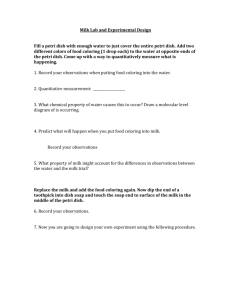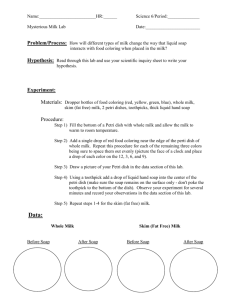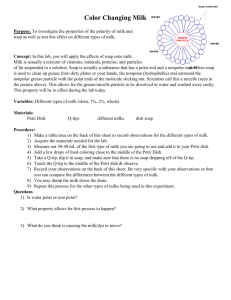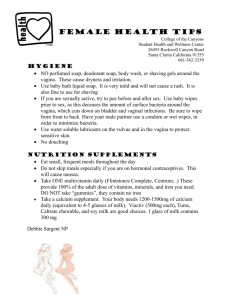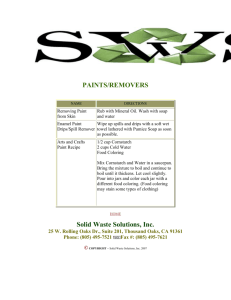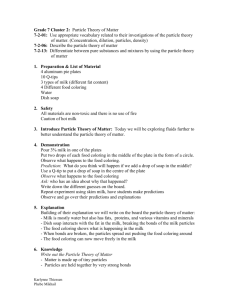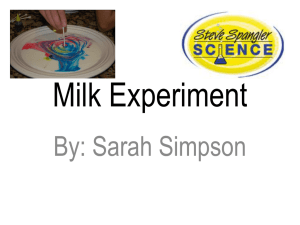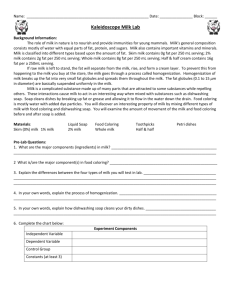Milk Rainbow
advertisement
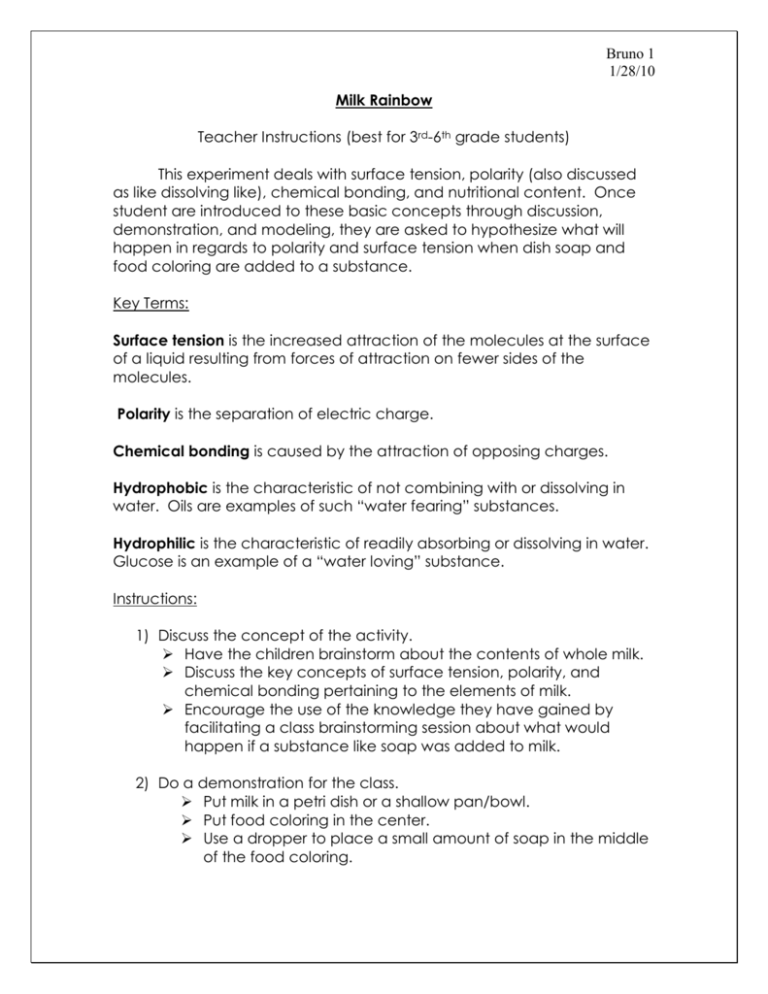
Bruno 1 1/28/10 Milk Rainbow Teacher Instructions (best for 3rd-6th grade students) This experiment deals with surface tension, polarity (also discussed as like dissolving like), chemical bonding, and nutritional content. Once student are introduced to these basic concepts through discussion, demonstration, and modeling, they are asked to hypothesize what will happen in regards to polarity and surface tension when dish soap and food coloring are added to a substance. Key Terms: Surface tension is the increased attraction of the molecules at the surface of a liquid resulting from forces of attraction on fewer sides of the molecules. Polarity is the separation of electric charge. Chemical bonding is caused by the attraction of opposing charges. Hydrophobic is the characteristic of not combining with or dissolving in water. Oils are examples of such “water fearing” substances. Hydrophilic is the characteristic of readily absorbing or dissolving in water. Glucose is an example of a “water loving” substance. Instructions: 1) Discuss the concept of the activity. Have the children brainstorm about the contents of whole milk. Discuss the key concepts of surface tension, polarity, and chemical bonding pertaining to the elements of milk. Encourage the use of the knowledge they have gained by facilitating a class brainstorming session about what would happen if a substance like soap was added to milk. 2) Do a demonstration for the class. Put milk in a petri dish or a shallow pan/bowl. Put food coloring in the center. Use a dropper to place a small amount of soap in the middle of the food coloring. Bruno 2 1/28/10 3) Have the children physically model what happened in the demonstration. Using signs or party hats, label each student as either soap, food coloring, water, or fat/protein. With the entire class, model what occurred at a molecular level when the soap and food coloring were added to the milk. 4) Using the color of their safety glasses, divide the kids into groups of four. Give each student a worksheet. Give each group 6 petri dishes or shallow bowls, two droppers, food coloring, crayons, dish soap, and the six substances that they will test. 5) Have them complete the activity using whole milk. Tell them to draw what they observe in the appropriate circle on their worksheets. 6) Have them complete the activity using water. Once again, have them draw their observations in the appropriate circle. Compare and contrast the outcomes when using water and milk. 7) Repeat step 6 using glue and shampoo. 8) Compare and contrast the different outcomes, and brainstorm the cause of the observed differences. 9) Present apple juice and a clear soda as mystery items, and have the students complete the activity with these mystery items. 10)The students should use the outcome of the activity with the mystery items to analyze characteristics of the liquids. 11) As a final element, mention the nutritional content of these liquids. 12)For clean up, everything is safe to pour down the drain. Further experiments/discussion: Take a more in-depth approach to nutrition. Discuss what it means for something to be hydrophobic and/or hydrophilic and the significance of these properties to this experiment. Have the kids bring in additional items for this activity. Total time: 40 mins Materials (estimated for a class of ~24 students): 37 petri dishes or shallow containers 3 sets of food coloring 12 droppers Bruno 3 1/28/10 Dish Soap Whole Milk Glue (such as Elmer’s) Water Clear Shampoo Apple Juice Clear Soda (ex. Sierra Mist) Crayons 1 box of small cups (to hold the substances being tested) Note: All of the materials needed for this experiment can be purchased at any general store. References: http://www.stevespanglerscience.com/experiment/00000066 Bruno 4 1/28/10 Key Terms Surface tension is the increased attraction of the molecules at the surface of a liquid resulting from forces of attraction on fewer sides of the molecules. Polarity is the separation of electric charge. Chemical bonding is caused by the attraction of opposing charges. Procedure Pour the milk into the petri dish or shallow bowl Drop food coloring into the center of the milk Draw dish soap into a dropper Put one drop of dish soap into the center of the food coloring Draw what you see when the soap touches the food coloring and milk… Bruno 5 1/28/10 Milk Repeat the activity substituting milk with water, clear shampoo, and glue. Make sure you draw what you observe. Water Bruno 6 1/28/10 Shampoo Glue Now that you know all about bonding, surface tension, and polarity, lets see what we can learn about some mystery liquids. Complete the activity with the given mystery liquids. Draw what you see and lets brainstorm about these liquids. Mystery 1 Mystery 2 Bruno 7 1/28/10 Write everything that you observed and learned about the first mystery liquid? From these observations, what can you say about the ingredients of the mystery liquid? What about the second mystery liquid?
